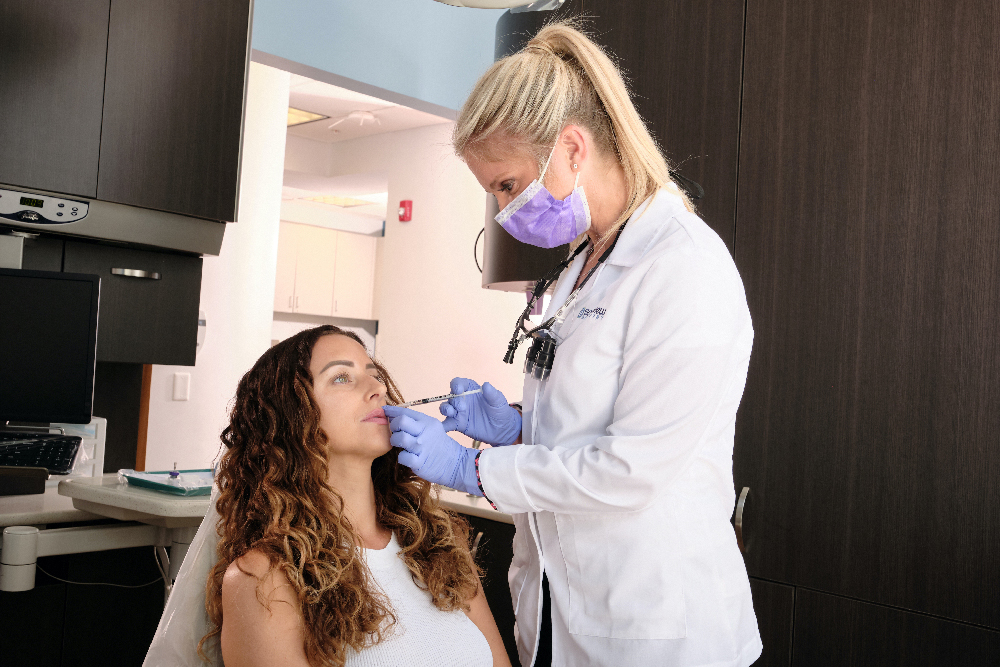Botox
If you are looking for Botox for TMJ or headaches, why not visit your dentist? Sometimes people are surprised to learn that some dentists provide Botox services.
However, in many ways, a skilled dentist is the ideal provider due to convenience and their precision and in-depth knowledge of the head and face.
Dr. Kelly Wilson at Southview Dentistry is not only a cosmetic and general dentist, but she is also a skilled Botox provider for TMJ and headaches.

What Is Botox?
Botox is an FDA-approved neuromodulator that temporarily stops muscle movement.
Your provider injects tiny doses of an approved toxin that relaxes the muscles and keeps them from moving. According to the Mayo Clinic, this toxin is made by the microbe that causes botulism.
Sometimes people are surprised to learn there are also medical and dental care uses for Botox injections, including treating chronic tension and migraine headaches, chronic tooth grinding, involuntary muscle twitches, and other conditions where relaxing specific muscles offer relief.
Why Choose a Dentist for Botox
The injectable has a range of therapeutic uses and is also sometimes used in dentistry. Dentists sometimes use Botox to treat Bruxism, TMJ, and headaches.
Combining dentistry with Botox injections is a convenient option for many patients. Imagine scheduling your Botox for TMJ or headaches at the same appointment as your dental cleaning or tooth whitening treatment!
Many professionals administer Botox, yet people are often surprised to learn dentists are among them. A skilled dentist treats the patient’s mouth and faces holistically. They are often the first to recognize early symptoms of various dental conditions due to their extensive knowledge of the head and face.
This same knowledge positions them to administer Botox injections for TMJ precisely. Besides, there are different reasons for jaw pain: muscle or joint.
A dentist has been properly trained in how the jaw functions, which makes them experts in TMJ disorders. Botox works only on the muscle, which means it would not help with true joint pain.
What to Expect From Botox Treatment
Dr. Kelly will first talk with you to learn about your goals, health history, and more. If you are already seeing her as a patient, you are already off to a great start!
Once confirming that Botox is appropriate for you, Dr. Kelly will strategically inject the Botox into the right muscles for your goals. The process is usually quick and relatively painless.
Most people start seeing results right away, but it can take a week or two for the peak results to emerge. Results typically last around three months, but each individual metabolizes differently.
Plan to avoid lying down or vigorous physical activity for a few hours after your injections. If you work out daily, be sure to do your workout before your injection. Many patients also see best results if they stop drinking alcohol and taking aspirin, fish oil, or other anti-inflammatory medicines and supplements for a few days before their treatment to help minimize the risk of bruising.
Discuss any medications or supplements you take with Dr. Kelly before your injections so she can provide you with accurate information specific to your situation.
How Botox Can Ease Headaches and TMJ Discomfort
Headaches and temporomandibular joint (TMJ) disorders can disrupt daily living by producing pain, discomfort, and decreased functionality. However, there is one viable remedy that may surprise you: Botox. This FDA-approved medication works by focusing on specific muscle groups involved in migraine pathogenesis and jaw dysfunction.
The temporomandibular joint (TMJ), located on both sides of the head where the jawbone joins the skull, is utilized for talking, eating, swallowing, and other daily tasks. If this joint gets dislocated or strained due to excessive teeth grinding, a person may experience severe tension headaches and intense jaw pain. Botox improves jaw strain by inhibiting muscles from engaging in the strong, often unconscious movement of the jaw that causes headaches and pain.
Botox injections are a promising treatment option for people who suffer from persistent migraines. Botox can also lessen the frequency and intensity of headaches by inhibiting the release of specific neurotransmitters involved in pain signaling, offering much-needed relief from distressing symptoms.
Does Botox Have Side Effects?
Most people experience no side effects or just minor side effects like mild pain at the injection site for a day or two. Dr. Kelly will discuss possible side effects, including rare, serious side effects. Be sure to follow her advice in the days and weeks following your treatment for the best results.Possible side effects include redness and soreness at the injection sites that last a few hours to a few days. Some people get headaches for a day or two or even long-term. This is less common since Botox is actually used to treat chronic headaches.
In highly rare instances, there are serious and sometimes life-threatening side effects. If you are new to Botox or need a refresher, be sure to ask Dr. Kelly since knowing what to look out for can save your life. If you experience a fever, lightheadedness, dizziness, paralysis, or other concerning symptoms in the days following Botox injections, seek immediate medical care.
Feel Confident Choosing Southview Dentistry for Botox®
Did you know that Dr. Kelly is IAFA certified? IAFA is the International Association of Facial Aesthetics. Dr. Kelly continues to perfect her craft and just recently completed her certification with IAFA. She is an expert in utilizing Botox® for TJM and headaches.

What Is the Recovery Like With Botox Therapy for TMJ Treatment?
Botox therapy for TMJ treatment has a comparatively short recovery time when compared to other surgical treatments. Following Botox injections for TMJ therapy, patients may experience minor discomfort or tenderness at the injection sites. This is normal and typically passes within a few hours to a few days.
Most patients can return to their normal daily activities soon following Botox injections for TMJ treatment. There is usually no need for rest or limits on exercise or eating. Avoid rubbing or massaging the treated area immediately after injections to prevent Botox from spreading to unwanted muscles.
While the full results of Botox therapy for TMJ treatment may take several days to manifest, patients may experience improvements in jaw discomfort, muscle tension, and headaches within the first week of treatment. Botox injections provide relief for three to six months on average, but this can vary from person to person.
What To Expect Post Botox TMJ Treatment
Patients who undergo Botox treatment for TMJ problems might expect a variety of favorable effects. For instance, there is frequently a significant decrease in jaw pain and muscular tension. This relief can have a cascading effect, resulting in fewer headaches linked with TMJ dysfunction. Also, patients may notice increased jaw movement and function, making routine tasks like eating, speaking, and yawning more pleasant and effortless.
The treatment of Botox TMJ may vary among individuals, with some experiencing immediate improvements and others experiencing gradual improvements over days or weeks. This slow improvement underscores the need for patience and continuous monitoring to comprehend the treatment's effects fully.
In terms of recovery, the treatment is usually painless, and most patients may return to their normal activities quickly. Unlike more intrusive procedures, such as surgery, Botox TMJ treatment usually has little to no downtime. However, patients must follow any post-treatment advice supplied by their healthcare professional. These guidelines may include avoiding intense activities or foods that may aggravate jaw muscle strain in the immediate aftermath of the treatment.

